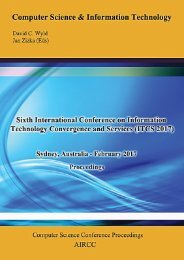CoSIT 2017
Fourth International Conference on Computer Science and Information Technology ( CoSIT 2017 ), Geneva, Switzerland - March 2017
Fourth International Conference on Computer Science and Information Technology ( CoSIT 2017 ), Geneva, Switzerland - March 2017
Create successful ePaper yourself
Turn your PDF publications into a flip-book with our unique Google optimized e-Paper software.
90 Computer Science & Information Technology (CS & IT)<br />
3. NETWORKING INFRASTRUCTURE<br />
In this section, we will discuss the foundation of the networking infrastructure that our new<br />
protocol will utilize to deliver the needed security.<br />
3.1. Secure Channel<br />
Secure channels between two parties are needed when the transmitted information is sensitive and<br />
private while traveling over an insecure medium (e.g., the Internet). The current practices referred<br />
to as SSL, which is for securing a channel for private communications will be discussed next.<br />
3.2. Secure Sockets Layer<br />
The current secure connection technology used on the Internet for securing communications<br />
between a client and a server is called SSL (Secure Sockets Layer), and its predecessor TLS<br />
(Transport Layer Security). Although TLS is the next generation of SSL, the term SSL is<br />
prevalent and therefore we will use it throughout this document.<br />
SSL protocol was originally developed by Netscape Communications in 1994 to address security<br />
issues of communicating via the Internet [1]. The protocol was a revolutionary technology for<br />
securing the Internet traffic that carried personal or sensitive information. The SSL technology is<br />
over two decades old and has evolved over time to be more secure. When new SSL vulnerabilities<br />
are discovered, computers become faster, and security demand of institutions grows, SSL will<br />
continue to evolve over time to address the needs of users. The workings of SSL depend on trust<br />
models provided by Certificate Authorities (CA) and public key infrastructure which is based on<br />
cryptography. Its underlying mechanisms protects the transmitted information integrity and<br />
security by providing authentication of the server to the client, and optionally provides<br />
authentication of the client to the server. Although SSL has several security features built-in, it is<br />
not immune to cyber-attacks (discussed in Section 8.2). Our new protocol will leverage SSL<br />
technology and its ability to secure the communications between client and server without any<br />
changes to this layer.<br />
3.3. Transport Layer<br />
The Transmission Control Protocol (TCP) and User Datagram Protocol (UDP) are located in this<br />
layer. TCP is a connection-oriented protocol and has three-way handshakes to establish the<br />
connection between the client (Initiator) and server (Receiver). TCP is the most reliable and<br />
prevalent protocol on the Internet because it guarantees packet delivery, ordering, and congestion<br />
control. UDP is a connection-less protocol that does not guarantee packet delivery and ordering<br />
which is typically used for streaming applications. The TCP along with IP layer, make up the<br />
TCP/IP protocol, which we will use as our transport layer protocol. No major changes are needed<br />
in this layer, however, with a minor exception that TCP flags might be set to flush out the<br />
packets.<br />
3.4. Secure versus Insecure Network Ports<br />
The TCP and UDP transport layer protocols have 65535 ports each. The Internet Assigned<br />
Numbers Authority (IANA) assigns the ports to be used for specific protocols and general use [2].<br />
Although some ports are used for secure protocol, there is no such thing as “secure” or “insecure”<br />
port numbers. The traffic that flows through network ports can be encrypted or in plain text.<br />
Hence it is up to the underlying protocol to use them as “secure” or “insecure” ports.





